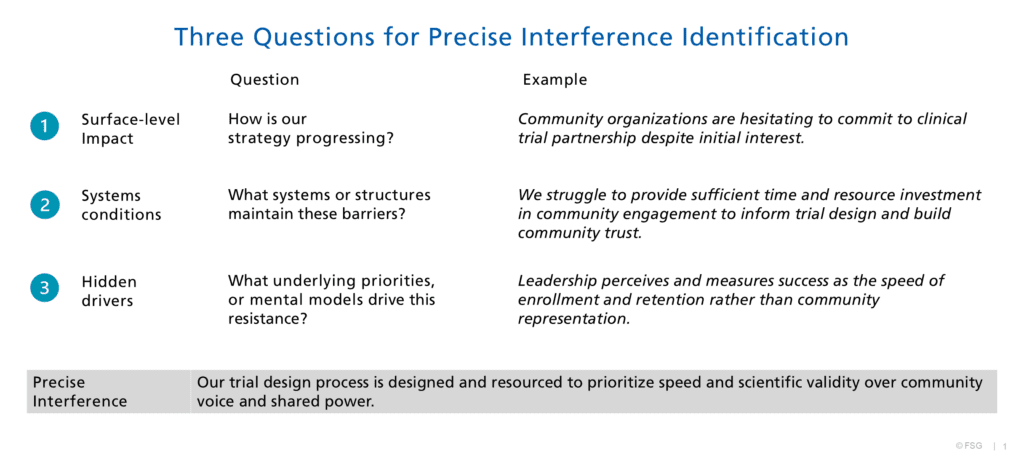Advancing Just Transitions: Four Considerations for Funders
Just transitions bring opportunities for people and economies through the creation of decent jobs, improved health outcomes, low-cost energy,…

A global healthcare company unveiled a comprehensive health equity strategy to increase access to quality, appropriate care for noncommunicable diseases regardless of socioeconomic background or geographic location. Backed by a new team and CEO promises of “transformative change,” the initiative seemed poised for success. After 18 months of significant investments to develop plans and implement patient awareness efforts, payment support schemes, and targeted market-building efforts, tangible progress has not been observed. Leaders blame implementation challenges and resource constraints, but the deeper reality is that both external and internal systems—from regulatory compliance requirements to performance incentives—were unconsciously designed to resist the very changes needed for genuine health equity progress.
Although this story does not belong to a specific company, it’s a plot that most healthcare leaders have read before. What appear as mere implementation hurdles often mask a more complex truth across the healthcare ecosystem: existing structures actively resist the disruption required to achieve health equity. These persistent obstacles, which we call “interferences,” are the systemic forces that actively resist the structural changes required for meaningful health equity progress.
Interferences operate at multiple levels, each requiring progressively deeper analysis to identify. For example, at the surface level, standard healthcare company policies intended to protect patients inadvertently discourage access to treatment. Examining the systems conditions reveals how pressures to achieve rapid performance results keep leaders consumed with day-to-day operations, unable to prioritize the longer-term efforts required for meaningful change. Probing even deeper into hidden drivers behind these interferences might uncover underlying beliefs, such as the assumption that addressing health disparities will not have an impact on business performance. To create sustainable solutions, corporate changemakers must move beyond surface-level observations to precisely identify the underlying systems conditions and hidden drivers holding these problems in place. We’ll explore this approach through our three-level framework for interference analysis in the sections that follow.
Without a clear diagnosis of the precise interferences blocking progress, resources are often diverted to ineffective solutions and fall short of intended impact. Here are a few examples of unintended consequences:

If you’re working to advance health equity in the corporate sector, you’ve likely lived some version of the fictional story above. The specifics might differ across organizations, but the underlying pattern remains consistent: hidden structural barriers silently undermine momentum and erode progress toward health equity goals. Without a predetermined approach to precisely identifying these interferences at all three levels: 1) surface-level impacts, 2) systems conditions, and 3) hidden drivers, even well-resourced initiatives can stall before achieving meaningful change.
Precision in identifying interferences is a crucial factor in unlocking transformative strategy potential. By identifying structural barriers, leaders can fundamentally reshape corporate approaches to equity. This process drives tangible business value. When healthcare organizations precisely identify interference, they can reveal inefficiencies that affect all customers, uncover opportunities for innovation, and build deeper trust with communities that translates to stronger market position.
We have previously written about how to leverage the six conditions of systems change to identify interferences. However, when twenty leaders from nine healthcare companies joined FSG’s 2024 Health Equity Purpose Studio to build their leadership skills to identify and address interference, the need for heightened precision became abundantly clear. By getting precise, leaders transform vague interference descriptions into tangible diagnoses that reveal systemic solutions. Here are some common interferences named during the 2024 Health Equity Purpose Studio, that when explored further, required more precision to accurately diagnose:
As corporate health leaders and their teams surface interference during strategic planning and/or implementation, they can consider the following line of questioning to ensure precision:

What surface-level challenge is your health equity initiative facing? Can you think about the different systems conditions that might be driving or perpetuating these challenges? The Six Conditions of Systems Change are a helpful place to start doing this analysis. Lastly, at the core of these challenges are often ways of being and thinking. Step back and ask yourself what key stakeholders, including yourself might be doing or thinking that undermines progress. After going through this reflection, look at what you’ve uncovered and name the precise interference causing the initial observed impact.
The journey from surface-level solutions to structural change begins with the courage to confront what lies beneath and the precision to identify exactly what we are up against. Effectively mitigating interference through enabling conditions often requires a leader’s deep awareness, intentionality, and willingness to go further. By naming and understanding the exact forces resisting change, health equity leaders can shift from addressing symptoms to reshaping systems.

Managing Director

Senior Consultant

Managing Director
Just transitions bring opportunities for people and economies through the creation of decent jobs, improved health outcomes, low-cost energy,…
Taking India’s growth story to the next level may well hinge on one critical lever: unlocking the full potential…
The journey from surface-level solutions to structural change begins with the courage to confront what lies beneath and the…
You will also receive email updates on new ideas and resources from FSG.
"*" indicates required fields
You will also receive email updates on new ideas and resources from FSG.
"*" indicates required fields
Get updates on new ideas and resources from FSG.
"*" indicates required fields
| Cookie | Duration | Description |
|---|---|---|
| cookielawinfo-checkbox-analytics | 11 months | This cookie is set by GDPR Cookie Consent plugin. The cookie is used to store the user consent for the cookies in the category "Analytics". |
| cookielawinfo-checkbox-functional | 11 months | The cookie is set by GDPR cookie consent to record the user consent for the cookies in the category "Functional". |
| cookielawinfo-checkbox-necessary | 11 months | This cookie is set by GDPR Cookie Consent plugin. The cookies is used to store the user consent for the cookies in the category "Necessary". |
| cookielawinfo-checkbox-others | 11 months | This cookie is set by GDPR Cookie Consent plugin. The cookie is used to store the user consent for the cookies in the category "Other. |
| cookielawinfo-checkbox-performance | 11 months | This cookie is set by GDPR Cookie Consent plugin. The cookie is used to store the user consent for the cookies in the category "Performance". |
| viewed_cookie_policy | 11 months | The cookie is set by the GDPR Cookie Consent plugin and is used to store whether or not user has consented to the use of cookies. It does not store any personal data. |
